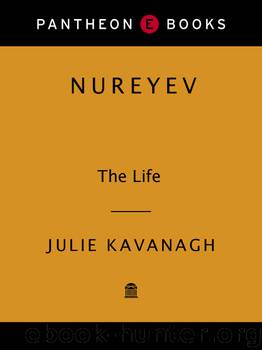Nureyev : The Life (9780307807342) by Kavanagh Julie

Author:Kavanagh, Julie [Kavanagh, Julie]
Language: eng
Format: epub
ISBN: 978-0-307-80734-2
Publisher: Random House Digital
Published: 2011-10-04T16:00:00+00:00
At this point, though, the end of the sixties, Rudolf was no longer demonstrating the flawlessness he had projected throughout most of the decade. Traveling relentlessly and working with different teachers, he had begun to lose the clarity of his arabesque line. Russian classes put great emphasis on the back, and without this constant practice, Rudolf’s strength and suppleness were deteriorating. At the same time it can be no coincidence that 1968, the year that trained eyes began to notice a decline in Rudolf’s technique, also marked the end of his love affair with Erik—his lodestar of purity and perfection.
On the other hand, technical decline was in itself a kind of liberation. For now Rudolf was able to accept the validity of the new—dance that “does not depend on beautiful line, unearthly balance, or sexual titillation,” in choreographer Paul Taylor’s words, but is “abstracted to express, in aesthetic form, the drives, desires and reactions of alive human beings.” Its pioneer, Isadora Duncan, used modern dance as a means of greater emotional communication; Martha Graham, to explore psychological ideas and complex personal relationships. It is a language that, as Rudolf himself recognized, “allows one to delve into one’s inner being” and, unlike classical ballet, one that sanctions the solo form. “Martha did all the ballets centered around herself. [Glen] Tetley did that for himself. And Taylor.” What would this unfamiliar idiom do for him? Rudolf wanted to know. “With these new movements: Will I be more expressive or less expressive?”
For a dancer who embodied freedom, bringing its “large, magical aura” with him onstage, it was only natural that he would want to “crash the gates” between ballet and modern dance, yet again crossing from a familiar world to an alien one. It was a period when there was still a great deal of hostility between the two genres, each being, in Rudolf’s words, “like a medieval fortress, with no exchange from the outside.” Although others before him had attempted a bridge, Rudolf, as choreographer Murray Louis acknowledges, deserves most of the credit for freeing the way for future dancers. “He took the plunge, he took the largest gamble, he had the most to lose.”
Rudolf’s first engagement with modern dance came about through a young Dutch choreographer whose work synthesized both forms of dance. Describing himself as “a sort of bastard between classical ballet and modern,” Rudi van Dantzig had been galvanized into making dance that reflected something of his own life and experience by seeing Martha Graham during her 1954 tour of Holland. Thirteen years later he was appointed codirector of the Dutch National Ballet, a company that greatly interested Rudolf because of its Balanchine repertory, then reputed to be the largest outside that of the New York City Ballet. Van Dantzig would not only continue to enrich DNB’s Balanchine heritage, and improve out of recognition the standard of the nineteenth-century classics, but also foster new choreography, himself creating psychodramatic pieces of originality and everyday relevance.
Of particular note was his 1965
Download
This site does not store any files on its server. We only index and link to content provided by other sites. Please contact the content providers to delete copyright contents if any and email us, we'll remove relevant links or contents immediately.
| Ballet | Ballroom |
| Choreography | Classical |
| Folk | Jazz |
| Modern | Notation |
| Popular | Reference |
| Tango | Tap |
Call Me by Your Name by André Aciman(18964)
Ready Player One by Cline Ernest(12837)
How to Be a Bawse: A Guide to Conquering Life by Lilly Singh(6692)
Wiseguy by Nicholas Pileggi(4585)
The Kite Runner by Khaled Hosseini(4430)
On Writing A Memoir of the Craft by Stephen King(4213)
The Crown by Robert Lacey(4105)
Audition by Ryu Murakami(4097)
Call me by your name by Andre Aciman(4071)
Harry Potter and the Cursed Child: The Journey by Harry Potter Theatrical Productions(3961)
Gerald's Game by Stephen King(3918)
The Perils of Being Moderately Famous by Soha Ali Khan(3782)
Dialogue by Robert McKee(3582)
Dynamic Alignment Through Imagery by Eric Franklin(3488)
Apollo 8 by Jeffrey Kluger(3199)
How to be Champion: My Autobiography by Sarah Millican(3185)
Seriously... I'm Kidding by Ellen DeGeneres(3100)
Darker by E L James(3087)
History of Dance, 2E by Gayle Kassing(3000)
